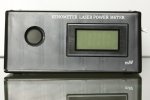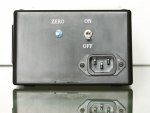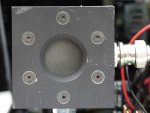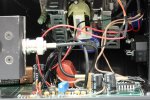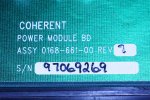- Joined
- Dec 21, 2008
- Messages
- 1,223
- Points
- 0
Intro
Today I'll be reviewing the one and only ***Ken-O-Meter*** from the community's one and only Kenom ("It's pronounced Ken-om not KEEEEEnom or keynom" ) The Kenometer, as it's name implies, is a Laser Power Meter (LPM). Kenom needs no introduction. Without him and the other local DIY Lasing junkies, LPF simply would cease to be, well, LPF
) The Kenometer, as it's name implies, is a Laser Power Meter (LPM). Kenom needs no introduction. Without him and the other local DIY Lasing junkies, LPF simply would cease to be, well, LPF  His friends call him Ken, but you & I can call him "Mr. Kenom, Sir".
His friends call him Ken, but you & I can call him "Mr. Kenom, Sir". 
Never judge a book by it's cover
It's an LPM In a box, a black box (BB-LPM for short. Not.) No, it's not just any LPM-in-a-box, but a thermal-sensor based LPM. Not just any thermal sensor, but a Coherent sensor, known as a Thermopile… And the accompanying circuitry is not just any PCB, but Coherent too. So anyone would be fooled in thinking they're just getting some "black box" LPM with components from anytown, mainland CN.
And the accompanying circuitry is not just any PCB, but Coherent too. So anyone would be fooled in thinking they're just getting some "black box" LPM with components from anytown, mainland CN.
Just like Kenom, Coherent doesn't need any introduction either. Just know that they're heavy players in the Industry and that buying pretty much anything from them directly will have a price tag with at least three zeros tacked on to it. So to be able to own an LPM with Coherent components for $250 (at time of writing) is simply amazing!
To the best of my knowledge, there are two main types of sensors; optical and thermal. The problem with optical is that you have to use a conversion table depending on the wavelength you are trying to measure. With a thermal sensor, no conversion is needed; just point, shoot and read The next great thing about this particular thermopile is that you get a lot of real estate. What this means is that you don't have to worry about having to line up the beam with the sensor to the nearest micrometer
The next great thing about this particular thermopile is that you get a lot of real estate. What this means is that you don't have to worry about having to line up the beam with the sensor to the nearest micrometer  The sensor's reactive area is about 2cm in diameter. Besides making for easier alignment, should you be silly enough to point a focused 2W laser at the sensor, you will have at least not burned the entire surface area in one go…
The sensor's reactive area is about 2cm in diameter. Besides making for easier alignment, should you be silly enough to point a focused 2W laser at the sensor, you will have at least not burned the entire surface area in one go… 
Long story short, this thermopile is the real deal.
Any color, so long as it's black
Back to the black Box. Well, let's see, it's ah… black Being the really nice guy that Kenom is, I did get offered the option of having it in another color (such a mauve, or maybe fuchsia, and so on… ) So I told him that he could paint it any color he liked so long as it's black (H. Ford). Hence, black box, just like the customer ordered
Being the really nice guy that Kenom is, I did get offered the option of having it in another color (such a mauve, or maybe fuchsia, and so on… ) So I told him that he could paint it any color he liked so long as it's black (H. Ford). Hence, black box, just like the customer ordered  Along with the black box, we have a few important switches, power socket, sensor opening, display and most importantly, really cool lettering c/o JayRob's better half
Along with the black box, we have a few important switches, power socket, sensor opening, display and most importantly, really cool lettering c/o JayRob's better half 
Regarding the switches, there's an I/O and a "0" switch. *Ah… what?* Yes, you read it right, a "0" switch, or "Zeroing pot", designed to compensate for fluctuations in ambient temperatures! Seems that thermal sensors are sensitive to thermal changes… (no way doode! ) so with a zeroing pot, you can be assured that you start your measurements at .000 every time. Sort of like the scale in your local supermarket's produce department (but chances are the scale is not from Coherent, nor from Kenom…).
) so with a zeroing pot, you can be assured that you start your measurements at .000 every time. Sort of like the scale in your local supermarket's produce department (but chances are the scale is not from Coherent, nor from Kenom…).
Now the zeroing feature is pretty sophisticated stuff but Kenom put some thought into even the most mundane functions, such as using an industry standard [PC] power cord (as well as universal power supply 110-240V). This means that when he sends it overseas, the recipient just has to grab any one of a number of old PC power cords laying around in the closet and plug it in. Very smart, indeed
Next up, the display. I'm no display expert, but Ken has recently had the need to change display types (because his provider changed the specs on the originals). I got a blue LCD display, some got green LED displays, and there are most likely Kenometers out there with blue LED and Green LCDs. Unfortunately no Fuchsia LEDs, another reason why I opted for the black finish instead… (right. lol.). Since I like taking photos of my gear, I prefer the LCD illumination to LEDs because the LEDs will quickly saturate compared to the rest of the kit. Otherwise, I can't say that there is a functional difference among the various display models; all are capable of displaying values in 1mW increments, which is exactly what we need. The Kenometer is designed to measure up to 2W "out of the box", but I have been informed that it can measure up to 10W with the help of a DMM (could be a digital multi meter...dunno ).
).
Nothing's perfect in this world and the Kenometer's no exception. There are a few "features" and/or "properties" that I didn't quite like. For one thing, the unit gets pretty warm to the touch. I don't have any professional thermal probes, but I'm guessing the power regulation components (situated at the top-rear of the unit, see image below) are hitting 40C+ and the black box is a sealed unit, more or less… . The reason for the lack of ventilation is that constant changes in temps around the sensor is a bad thing, possibly affecting accuracy. I have spoken with the Kenometer's chief architect (ah, that would be Kenom - and It's pronounced Ken-om not KEEEEEnom or keynom, got it?) about the possibility of isolating the sensor from the other components, allowing for air flow in those areas without affecting the sensor itself. The only other minor issue, one that will affect only 2.33% of all Kenometers, is the use of a 9V battery to power the display. The battery is hard to replace by a non-DIYers like myself, but as I said, it's only going to affect, ah... me, since the other guys that got such an "edition" are DIYers anyways, lol
Can it walk the walk?
Most importantly, the LPM does what it's supposed to, which is to accurately measure a laser's output. Accuracy is relative and when measuring 100~500mW lasers, I think that a variance of +/-5mW would be more than acceptable. I am not certain what the actual speced variances are with this particular setup, but I am pretty sure it's in the low mWs (to be clarified). I knew that Kenom would properly calibrate the Kenometer before shipping, but with shipping, anything can happen.
So I took a few of my lasers made by very dependable members such as The Professor "Peace, Dave" Daguin. He recently shipped me a 6x BR set for 180mW. It measured 182mW on the Kenometer. I did said check with a few other lasers and I am confident that the unit is accurate!
Wrapping it all up
Well that's pretty much it and I've covered all the critical areas. Wait, did I forget anything…? Nah, just kiddin' y'all - I'd never forget the most important part of the Kenometer and that's the "Ken" behind the [o]meter Just have a look at his Kenometer BST thread to get an idea of the time and effort he put forth to keep his partners informed, from the point of ordering and receiving the parts to the final builds. And between all the posts on that four-page thread, rest assured there were many a PM sent from him to each individual partner. Not only did he inform us of the positive milestones, but he was just as willing to discuss the few issues that crept up during the process.
Just have a look at his Kenometer BST thread to get an idea of the time and effort he put forth to keep his partners informed, from the point of ordering and receiving the parts to the final builds. And between all the posts on that four-page thread, rest assured there were many a PM sent from him to each individual partner. Not only did he inform us of the positive milestones, but he was just as willing to discuss the few issues that crept up during the process.
This man does not fear the truth and will be the first one to admit something has gone wrong, be it in or out of his control. But don't let all this praise fool you; if he's confident of a statement he's made or a design decision he's taken, he's not going to fold just for the sake of pleasing or appeasing you. Hence, there's no BS to filter out when it comes to dealing with Kenom (and remember, it's pronounced Ken-om not KEEEEEnom or keynom) and that's a good thing
The Kenometer is a sleeper - a low-key body with a whole lot of horsepower just underneath it's hood. Not only do you get professional-level HW inside, but a good man in the pit should something go wrong.
Highly Recommended!
Today I'll be reviewing the one and only ***Ken-O-Meter*** from the community's one and only Kenom ("It's pronounced Ken-om not KEEEEEnom or keynom"
Never judge a book by it's cover
It's an LPM In a box, a black box (BB-LPM for short. Not.) No, it's not just any LPM-in-a-box, but a thermal-sensor based LPM. Not just any thermal sensor, but a Coherent sensor, known as a Thermopile…
Just like Kenom, Coherent doesn't need any introduction either. Just know that they're heavy players in the Industry and that buying pretty much anything from them directly will have a price tag with at least three zeros tacked on to it. So to be able to own an LPM with Coherent components for $250 (at time of writing) is simply amazing!
To the best of my knowledge, there are two main types of sensors; optical and thermal. The problem with optical is that you have to use a conversion table depending on the wavelength you are trying to measure. With a thermal sensor, no conversion is needed; just point, shoot and read
Long story short, this thermopile is the real deal.
Any color, so long as it's black
Back to the black Box. Well, let's see, it's ah… black
Regarding the switches, there's an I/O and a "0" switch. *Ah… what?* Yes, you read it right, a "0" switch, or "Zeroing pot", designed to compensate for fluctuations in ambient temperatures! Seems that thermal sensors are sensitive to thermal changes… (no way doode!
Now the zeroing feature is pretty sophisticated stuff but Kenom put some thought into even the most mundane functions, such as using an industry standard [PC] power cord (as well as universal power supply 110-240V). This means that when he sends it overseas, the recipient just has to grab any one of a number of old PC power cords laying around in the closet and plug it in. Very smart, indeed
Next up, the display. I'm no display expert, but Ken has recently had the need to change display types (because his provider changed the specs on the originals). I got a blue LCD display, some got green LED displays, and there are most likely Kenometers out there with blue LED and Green LCDs. Unfortunately no Fuchsia LEDs, another reason why I opted for the black finish instead… (right. lol.). Since I like taking photos of my gear, I prefer the LCD illumination to LEDs because the LEDs will quickly saturate compared to the rest of the kit. Otherwise, I can't say that there is a functional difference among the various display models; all are capable of displaying values in 1mW increments, which is exactly what we need. The Kenometer is designed to measure up to 2W "out of the box", but I have been informed that it can measure up to 10W with the help of a DMM (could be a digital multi meter...dunno
Nothing's perfect in this world and the Kenometer's no exception. There are a few "features" and/or "properties" that I didn't quite like. For one thing, the unit gets pretty warm to the touch. I don't have any professional thermal probes, but I'm guessing the power regulation components (situated at the top-rear of the unit, see image below) are hitting 40C+ and the black box is a sealed unit, more or less… . The reason for the lack of ventilation is that constant changes in temps around the sensor is a bad thing, possibly affecting accuracy. I have spoken with the Kenometer's chief architect (ah, that would be Kenom - and It's pronounced Ken-om not KEEEEEnom or keynom, got it?) about the possibility of isolating the sensor from the other components, allowing for air flow in those areas without affecting the sensor itself. The only other minor issue, one that will affect only 2.33% of all Kenometers, is the use of a 9V battery to power the display. The battery is hard to replace by a non-DIYers like myself, but as I said, it's only going to affect, ah... me, since the other guys that got such an "edition" are DIYers anyways, lol
Can it walk the walk?
Most importantly, the LPM does what it's supposed to, which is to accurately measure a laser's output. Accuracy is relative and when measuring 100~500mW lasers, I think that a variance of +/-5mW would be more than acceptable. I am not certain what the actual speced variances are with this particular setup, but I am pretty sure it's in the low mWs (to be clarified). I knew that Kenom would properly calibrate the Kenometer before shipping, but with shipping, anything can happen.
So I took a few of my lasers made by very dependable members such as The Professor "Peace, Dave" Daguin. He recently shipped me a 6x BR set for 180mW. It measured 182mW on the Kenometer. I did said check with a few other lasers and I am confident that the unit is accurate!
Wrapping it all up
Well that's pretty much it and I've covered all the critical areas. Wait, did I forget anything…? Nah, just kiddin' y'all - I'd never forget the most important part of the Kenometer and that's the "Ken" behind the [o]meter
This man does not fear the truth and will be the first one to admit something has gone wrong, be it in or out of his control. But don't let all this praise fool you; if he's confident of a statement he's made or a design decision he's taken, he's not going to fold just for the sake of pleasing or appeasing you. Hence, there's no BS to filter out when it comes to dealing with Kenom (and remember, it's pronounced Ken-om not KEEEEEnom or keynom) and that's a good thing
The Kenometer is a sleeper - a low-key body with a whole lot of horsepower just underneath it's hood. Not only do you get professional-level HW inside, but a good man in the pit should something go wrong.
Highly Recommended!
Attachments
Last edited:



